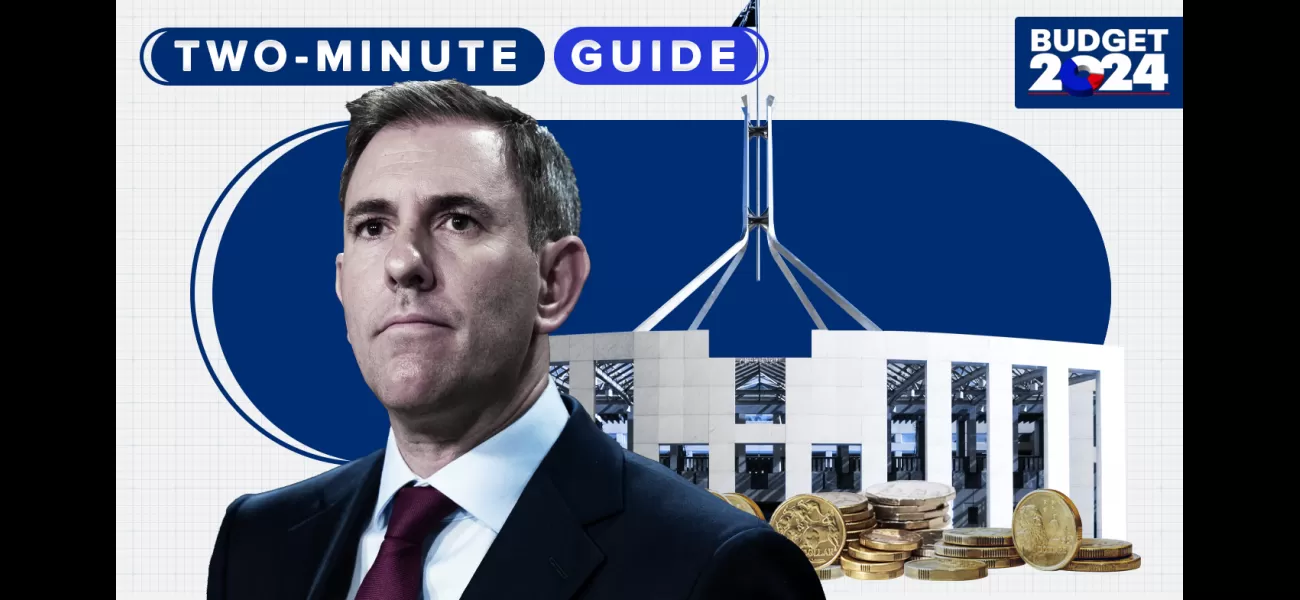Help for those struggling to pay bills includes financial aid, rental support, and prescription price freeze.
The third federal budget by Treasurer Jim Chalmers includes $7.8 billion in measures to ease cost-of-living for Australian families.
May 14th 2024.

The highly anticipated third federal budget has been delivered by Treasurer Jim Chalmers, and it includes a whopping $7.8 billion in cost-of-living relief for Australian households. This relief comes in the form of $300 energy bill rebates, a freeze on the cost of medicines, and increased rent assistance. Chalmers emphasized that these policies are designed to address the issue of sticky inflation while also providing much-needed support to those who are struggling.
According to Chalmers, this budget is not only focused on the present, but also looks towards the future. He described it as a responsible budget that aims to help people in need while also investing in the potential of a more prosperous future for all Australians. The $9.3 billion surplus forecasted for 2023-24 is a significant improvement from the December prediction, but the budget also reveals that future balance sheets are not as positive as previously thought.
As with any budget, there are both winners and losers. Chalmers acknowledged this and stated that the budget is for every Australian, regardless of their circumstances. The $7.8 billion in cost-of-living relief includes previously legislated changes to tax cuts, energy bill relief, freezes on some medicines, and increased Commonwealth Rent Assistance. The Treasury has predicted that these measures will help reduce inflation and play a crucial role in achieving the target band of 2 to 3 per cent.
While the Reserve Bank of Australia has a more conservative prediction for inflation, the budget papers state that it could return to the target band by the end of this year. However, this does not mean that interest rates will be cut anytime soon. The budget papers predict that the cash rate will gradually ease from mid-2025, reaching 3.6 per cent by mid-2026.
One notable exclusion from this budget is an increase in the maximum rate of JobSeeker, something that has been called for by independent government advisers. Instead, the budget includes an expansion of eligibility for the highest rate for about 4700 recipients who can work up to 14 hours per week, resulting in a fortnightly increase of $54.90.
While Chalmers is the first treasurer to deliver back-to-back surpluses since the Global Financial Crisis, the forecast for the coming years is not as optimistic, with eye-watering deficits of $28.3 billion in 2024-25, $42.8 billion in 2025-26, $26.7 billion in 2026-27, and $24.3 billion in 2027-28. Chalmers attributed these future budget blowouts to unavoidable spending, such as upgrades to the myGov system and the $22.7 billion Future Made in Australia package, which aims to boost investment and make the country a renewable energy superpower.
Despite acknowledging the global challenges and uncertain economic conditions, Chalmers remains optimistic about Australia's economy and its ability to thrive. He stated that the budget reflects the government's high aspirations and ambitions to make Australians the primary beneficiaries of a rapidly changing world.
One of the most significant announcements in this year's budget is the $3.5 billion in energy bill relief for households and small businesses. This relief will come in the form of rebates of $300 for over 10 million households and $325 for one million small businesses from July 1. Additionally, there will be a one-year freeze on the maximum patient co-payment on the Pharmaceutical Benefits Scheme, costing $3 billion. This means that no one with a Medicare card will pay more than $31.60 for their prescriptions in the next two years. Pensioners and concession cardholders will see their maximum co-payment frozen for five years at $7.70.
Furthermore, the maximum rate of Commonwealth Rent Assistance will increase by 10 per cent, costing $1.9 billion over five years. This will provide an additional $70 per fortnight for families with children and comes after a 15 per cent increase in last year's budget. The government estimates that nearly one million households will benefit from this increase, considering the 7.8 per cent increase in rents in the past year.
The budget also includes the previously passed stage 3 tax cuts, which will be implemented from July 1. On average, taxpayers will receive a tax cut of $1888 or $36 per week in 2024/25. By 2034/35, an average income earner will pay $21,915 less tax. Chalmers stated that these tax cuts are better for families, communities, women, young people, and the economy.
Small businesses will also benefit from this budget, with $325 in energy bill relief and an extension of the $20,000 instant asset write-off until June 30, 2025. Additionally, 457 "nuisance tariffs" will be abolished from July 1, simplifying Australia's trade system and reducing compliance costs for businesses, particularly small businesses.
Overall, Chalmers has delivered a budget that addresses both current and future challenges while also providing much-needed support to Australian households and businesses. With a focus on cost-of-living relief, tax cuts, and investments in industry and renewable energy, this budget aims to make Australia a stronger and more resilient nation in the face of global changes.
According to Chalmers, this budget is not only focused on the present, but also looks towards the future. He described it as a responsible budget that aims to help people in need while also investing in the potential of a more prosperous future for all Australians. The $9.3 billion surplus forecasted for 2023-24 is a significant improvement from the December prediction, but the budget also reveals that future balance sheets are not as positive as previously thought.
As with any budget, there are both winners and losers. Chalmers acknowledged this and stated that the budget is for every Australian, regardless of their circumstances. The $7.8 billion in cost-of-living relief includes previously legislated changes to tax cuts, energy bill relief, freezes on some medicines, and increased Commonwealth Rent Assistance. The Treasury has predicted that these measures will help reduce inflation and play a crucial role in achieving the target band of 2 to 3 per cent.
While the Reserve Bank of Australia has a more conservative prediction for inflation, the budget papers state that it could return to the target band by the end of this year. However, this does not mean that interest rates will be cut anytime soon. The budget papers predict that the cash rate will gradually ease from mid-2025, reaching 3.6 per cent by mid-2026.
One notable exclusion from this budget is an increase in the maximum rate of JobSeeker, something that has been called for by independent government advisers. Instead, the budget includes an expansion of eligibility for the highest rate for about 4700 recipients who can work up to 14 hours per week, resulting in a fortnightly increase of $54.90.
While Chalmers is the first treasurer to deliver back-to-back surpluses since the Global Financial Crisis, the forecast for the coming years is not as optimistic, with eye-watering deficits of $28.3 billion in 2024-25, $42.8 billion in 2025-26, $26.7 billion in 2026-27, and $24.3 billion in 2027-28. Chalmers attributed these future budget blowouts to unavoidable spending, such as upgrades to the myGov system and the $22.7 billion Future Made in Australia package, which aims to boost investment and make the country a renewable energy superpower.
Despite acknowledging the global challenges and uncertain economic conditions, Chalmers remains optimistic about Australia's economy and its ability to thrive. He stated that the budget reflects the government's high aspirations and ambitions to make Australians the primary beneficiaries of a rapidly changing world.
One of the most significant announcements in this year's budget is the $3.5 billion in energy bill relief for households and small businesses. This relief will come in the form of rebates of $300 for over 10 million households and $325 for one million small businesses from July 1. Additionally, there will be a one-year freeze on the maximum patient co-payment on the Pharmaceutical Benefits Scheme, costing $3 billion. This means that no one with a Medicare card will pay more than $31.60 for their prescriptions in the next two years. Pensioners and concession cardholders will see their maximum co-payment frozen for five years at $7.70.
Furthermore, the maximum rate of Commonwealth Rent Assistance will increase by 10 per cent, costing $1.9 billion over five years. This will provide an additional $70 per fortnight for families with children and comes after a 15 per cent increase in last year's budget. The government estimates that nearly one million households will benefit from this increase, considering the 7.8 per cent increase in rents in the past year.
The budget also includes the previously passed stage 3 tax cuts, which will be implemented from July 1. On average, taxpayers will receive a tax cut of $1888 or $36 per week in 2024/25. By 2034/35, an average income earner will pay $21,915 less tax. Chalmers stated that these tax cuts are better for families, communities, women, young people, and the economy.
Small businesses will also benefit from this budget, with $325 in energy bill relief and an extension of the $20,000 instant asset write-off until June 30, 2025. Additionally, 457 "nuisance tariffs" will be abolished from July 1, simplifying Australia's trade system and reducing compliance costs for businesses, particularly small businesses.
Overall, Chalmers has delivered a budget that addresses both current and future challenges while also providing much-needed support to Australian households and businesses. With a focus on cost-of-living relief, tax cuts, and investments in industry and renewable energy, this budget aims to make Australia a stronger and more resilient nation in the face of global changes.
[This article has been trending online recently and has been generated with AI. Your feed is customized.]
[Generative AI is experimental.]
0
0
Submit Comment





